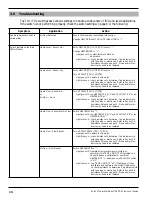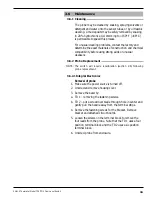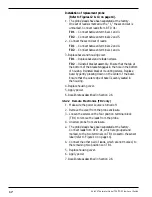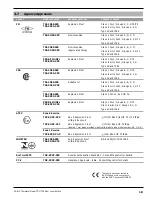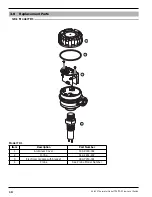
4
54-610 Thermatel Model TD1/TD2 Flow Level Switch
2.4.1 Relay Connections
TD1/TD2:
DPDT
8 amp at 120–250 VAC
8 amp at 30 VDC, 0.5 amp at 125 VDC resistive
TD2 with Hermetically sealed relay:
DPDT 1 amp at 28 VDC, 0.5 amp at 125 VDC resistive
The switch may be configured so that the relay either
energizes or de-energizes when the set point is reached.
Locating the fail-safe switch in the LL position places the
switch in a low level fail-safe (LLFS) position. This causes
the relay to energize when the flow rate is higher than the
set point or when the sensor is immersed. Locating the
fail-safe switch in the HL position places the switch in a
high level fail-safe (HLFS) position. This causes the relay to
energize when the flow rate is less than the set point or
when the sensor is dry. Refer to the following chart.
Power
Flow Level
Fail-Safe Position
Relay Coil
Relay Terminal
NC to CO
NO to CO
On
High
HLFS
De-energized
Closed
Open
LLFS
Energized
Open
Closed
On
Low
HLFS
Energized
Open
Closed
LLFS
De-energized
Closed
Open
Fail
High
HLFS
De-energized
Closed
Open
LLFS
De-energized
Closed
Open
Fail
Low
HLFS
De-energized
Closed
Open
LLFS
De-energized
Closed
Open
Chart Notes and Definitions
1. Equipment controlled by the Thermatel relay is assumed to be powered from one
source, while the Thermatel unit itself is assumed to be powered from a different
source.
2. “Fail” means a loss of power to the Thermatel unit.
3. HL means a flow rate or level which is above the adjusted set point.
4. LL means a flow rate or level which is less than the adjusted set point.
5. When the relay coil is de-energized, a connection is made between the terminals
CO (common) and NC (normally closed), and there is no connection between CO
and NO (normally open).
6. When the relay coil is energized, a connection is made between the terminals CO
and NO, and there is no connection between CO and NC.


















